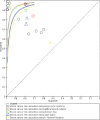Diagnostic Accuracy of Different Machine Learning Algorithms for Breast Cancer Risk Calculation: a Meta-Analysis
- PMID: 30049182
- PMCID: PMC6165638
- DOI: 10.22034/APJCP.2018.19.7.1747
Diagnostic Accuracy of Different Machine Learning Algorithms for Breast Cancer Risk Calculation: a Meta-Analysis
Abstract
Objective: The aim of this study was to determine the diagnostic accuracy of different machine learning algorithms for breast cancer risk calculation. Methods: A meta-analysis was conducted of published research articles on diagnostic test accuracy of different machine learning algorithms for breast cancer risk calculation published between January 2000 and May 2018 in the online article databases of PubMed, ProQuest and EBSCO. Paired forest plots were employed for the analysis. Numerical values for sensitivity and specificity were obtained from false negative (FN), false positive (FP), true negative (TN) and true positive (TP) rates, presented alongside graphical representations with boxes marking the values and horizontal lines showing the confidence intervals (CIs). Summary receiver operating characteristic (SROC) curves were applied to assess the performance of diagnostic tests. Data were processed using Review Manager 5.3 (RevMan 5.3). Results: A total of 1,879 articles were reviewed, of which 11 were selected for systematic review and meta-analysis. Fve algorithms for machine learning able to predict breast cancer risk were identified: Super Vector Machine (SVM); Artificial Neural Networks (ANN); Decision Tree (DT); Naive Bayes (NB); and K-Nearest Neighbor (KNN). With the SVM, the Area Under Curve (AUC) from the SROC was > 90%, therefore classified into the excellent category. Conclusion: The meta-analysis confirmed that the SVM algorithm is able to calculate breast cancer risk with better accuracy value than other machine learning algorithms.
Keywords: Breast cancer risk; calculation; machine learning.
Creative Commons Attribution License
Figures







References
-
- Akay MF. Support vector machines combined with feature selection for breast cancer diagnosis. Expert Syst Appl. 2009;36:3240–7.
-
- Asri H, Mousannif H, Al moatassime H, Noel T. Using machine learning algorithms for breast cancer risk prediction and diagnosis. Procedia Comput Sci. 2016;83:1064–9.
-
- Bradley AP. The use of the area under the ROC curve in the evaluation of machine learning algorithms. Pattern Recognit. 1997;30:1145–59.
-
- Carey LA, Perou CM, Livasy CA, et al. Race, breast cancer subtypes, and survival in the carolina breast cancer study. JAMA. 2006;295:2492–502. - PubMed
Publication types
MeSH terms
LinkOut - more resources
Full Text Sources
Medical
Miscellaneous

